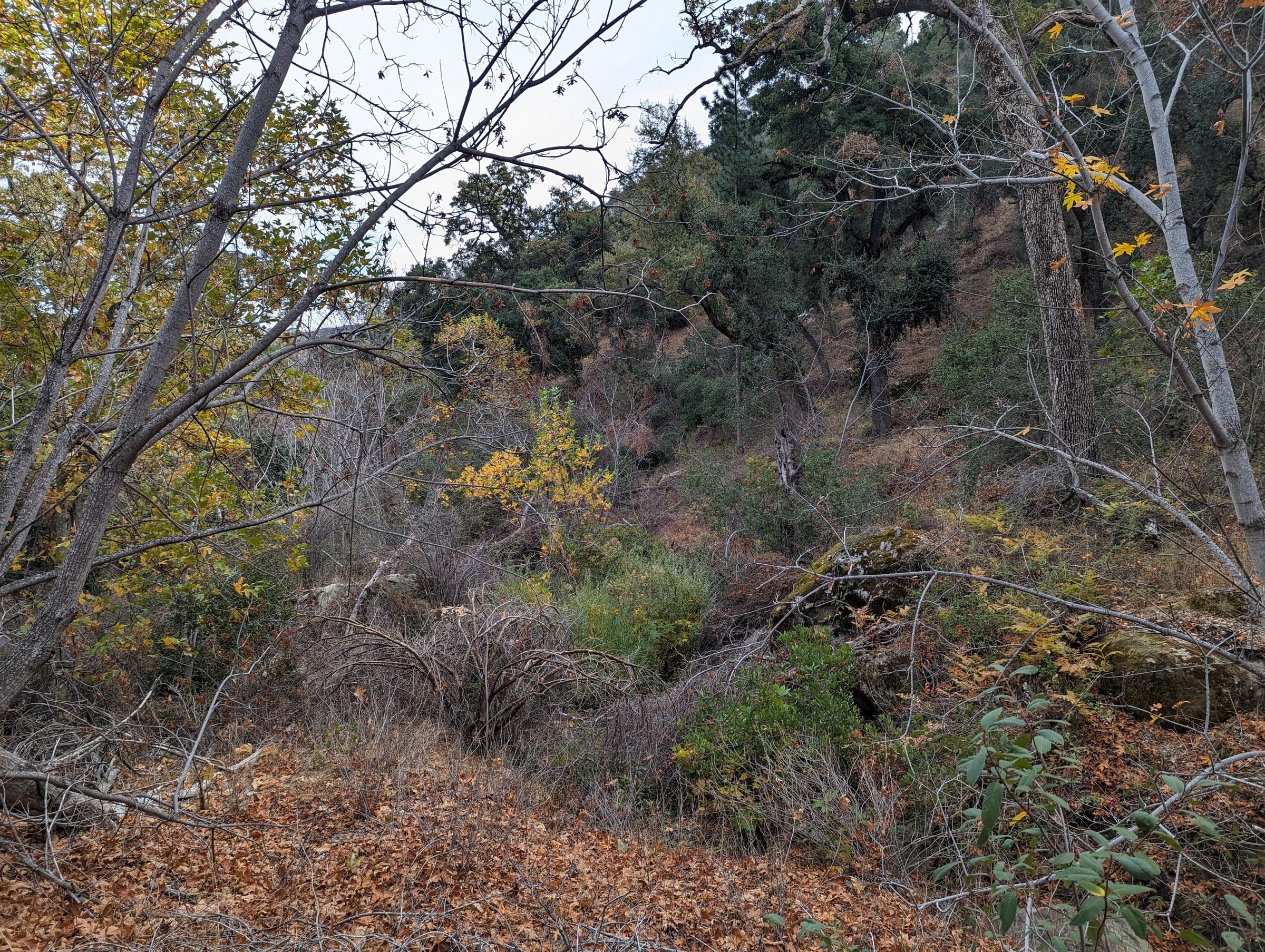Willow Spring Trail

Willow Spring Trail
Tips for Birding
Hike slowly up from Davy Brown Trail, taking advantage of frequent stop-and-listen breaks to catch your breath from the steep ascent.
Birds of Interest
Varied Thrush and Pacific Wren are regular wintering birds here and are respectively most likely in berry-laden toyon and dense, streamside tangles of brush.
In the past, Townsend's Soitaire has used this area in winter, too. Check woodlands for Brown Creeper. In the conifers at higher elevations, look for montane birds like Mountain Chickadee and Steller's Jay; rarer birds might wander here, particularly in irruptive winters.
About this Location
A spring keeps surface water flowing here all year, which also feeds a concentration of winter-deciduous, shallow-rooted, groundwater-dependent trees like willow and maple. The spring thereby attracts birds by altering vegetation, providing resources for food insects, and by directly providing water for bathing and drinking in an otherwise dry landscape.
About Figueroa Mountain Area
See all hotspots at Figueroa Mountain Area
This hotspot group includes 15 hotspots in the vicinity of Figueroa Mountain, all of which are within a 30-or-so-minute drive from one another; several can be birded in the same morning.
Many of these hotspots are dominated by pine forest, sometimes mixed in with oaks. Some shady north slopes grade from pine forest into bigcone Douglas-fir. On Figueroa Mountain proper these habitats include Catway Rd. on the north slope; Pino Alto Picnic Area near the summit; Figueroa Mtn. summit; and Pino Alto Rd. going up to the summit. Similar pine-dominated habitat is also found on and near Ranger Peak, including the Ranger Peak hotspot itself and East Pinery.
Many of the region's montane species are regularly found here, including Mountain Chickadee, Golden-crowned Kinglet, Red-breasted Nuthatch, Pygmy Nuthatch, Red-breasted Sapsucker, Brown Creeper, Townsend's Solitaire. Less frequently recorded species include Williamson's Sapsucker, Red-naped Sapsucker, White-headed Woodpecker, Red Crossbill, and Cassin's Finch. Casual visitors include Clark's Nutcracker, Evening Grosbeak, and Green-tailed Towhee.
Figueroa Mountain and its environs form one of only a handful of areas with high-altitude pine forests in Santa Barbara County, the others being San Rafael Mountain, Big Pine Mountain, and Madulce Peak.
The pine forest habitat has been diminished by forest fires over the last two decades, and some species have been extirpated as breeders. As such, while eBird bar charts show some of these species occurring year-round, these days, most of them are only seen in winter.
At slightly lower altitudes, the pine forest is replaced by mixed oak woodlands that also include manzanitas and a variety of other evergreen species. Creeks flowing through the woodland and down the north slope of the mountains feature perennial summer flows and shady canopies of sycamore and bigleaf maple. Hotspots with this habitat include Figueroa Mtn. Campground; Davy Brown Trail; NIRA Campground and Manzana Creek east of Lower Manzana Trailhead; Davy Brown Campground; Munch Canyon between East Pinery and Davy Brown campground; and Willow Spring Trail.
These areas, often bordered by grasslands or chaparral, are home to breeding songbirds like Olive-sided Flycatcher, Black-throated Gray Warbler, Western Wood-Pewee, Ash-throated Flycatcher, Cassin's Vireo, Warbling Vireo, Western Tanager (formerly?), and Black-headed Grosbeak. Some of these also breed in the higher-altitude pine forest.
The Figueroa Mountain area is also worth checking during spring and fall migration when it sometimes attracts many migrating passerines. For example, Hammond's and Willow Flycatchers, as well as Hermit Warblers, have been seen here in spring.
Several species of owl occur in this area and can be found in various habitats. This includes Western Screech-Owl, Great Horned Owl, Northern Pygmy-Owl, Northern Saw-whet Owl, and Spotted Owl.
Other species that can be found here are Mountain Quail, Common Poorwill (sometimes flushed from the road at night), Golden Eagle, Steller's Jay, Violet-green Swallow, Varied Thrush, Pacific Wren, and Lawrence's Goldfinch. Hermit Thrush and Fox Sparrow are common in winter.
Notable Trails
The easiest access to Willow Spring is by foot uphill from Davy Brown Campground. The campground is accessible via road, and you can park outside it and then walk up the trail, turning right when you reach the sign for Willow Spring Trail (34.753062,-119.966871).
Note that the trails are in some places very steep, narrow, and can be rugged and difficult to traverse after rainstorm damage.
Content from Conor McMahon and Linus Blomqvist
Last updated December 24, 2023